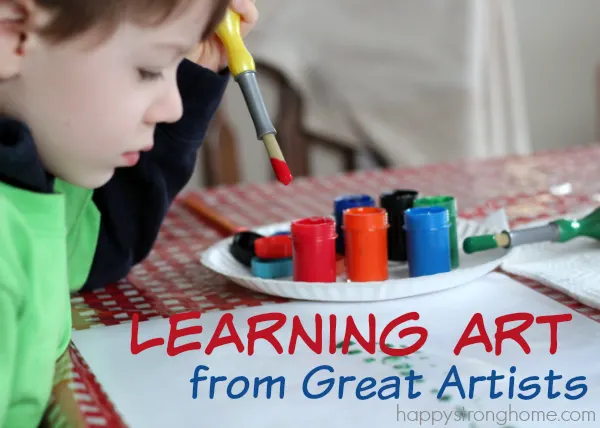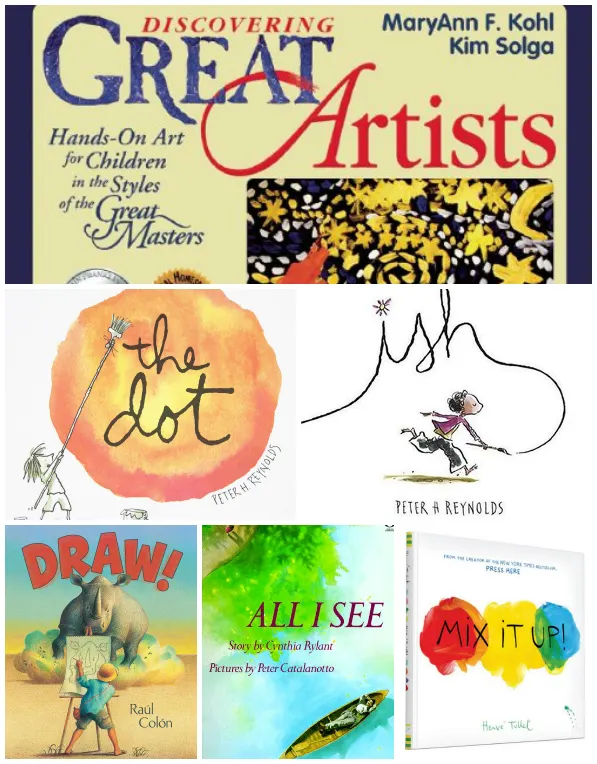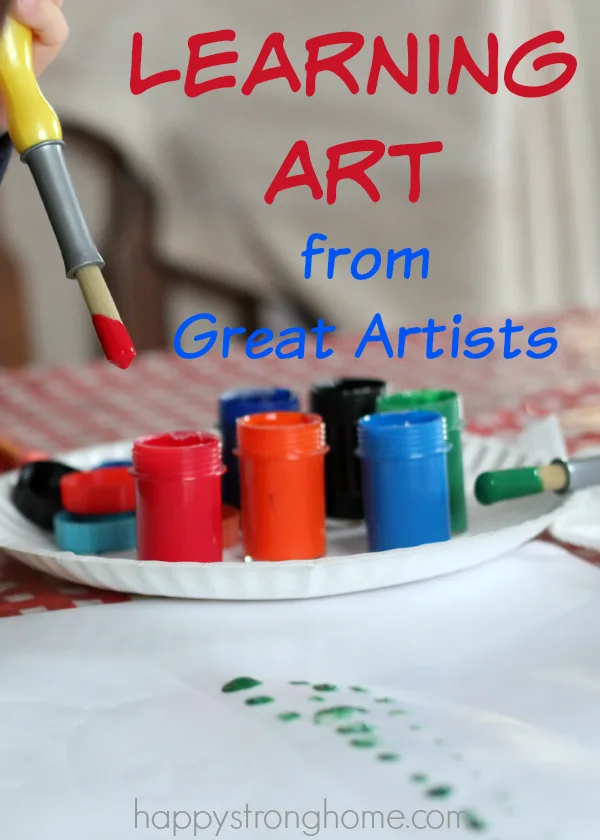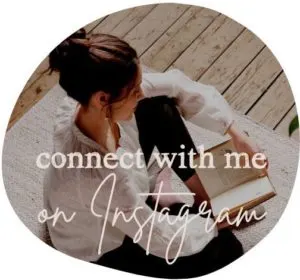One of my favorite segments of the Classical Conversations (CC) community we joined this past fall is the half hour of art. I am not personally gifted with much artistic ability. Most of my skills are in textile arts like sewing and rubber stamping, and even then, I don’t have the same artistic vision of most people. So I love seeing our oldest explore art techniques, concepts and skills in a group like this.
We’ve been using the Discovering Great Artists book, and through both the book and my experiences, I am learning a lot about how even without much artistic skill on my end, I can bring art into our homeschooling in a big way. Here’s a few of the ways we’re learning art with famous artists.

Share artist backgrounds
It’s simple enough to get a few snippets about an artists life that will interest kids. Like how Grandma Moses was completely untrained and didn’t start painting until she was, well, a Grandma in her eighties (it’s never too late!)! Or how Andrew Wyeth was homeschooled! Kids love to find a connection between an historical figure and their own lives, so make those tie-ins!
Another option is to check out your local art museums. We have two in our area: The New Britain Museum of American Art, and the Wadsworth Atheneum. The Wadsworth has a wonderful FREE art program for families every Second Saturday where kids can create arts and crafts, view art, and even go on a docent led tour!
Copy an artist’s style and technique
Kids can make pop art like Lichtenstein using simple dots. This is a great chance to explore pointillism technique! See more ideas on how to explore pointillism for kids on the Melissa & Doug blog today!). Or create large close up paintings of a simple subject like Georgia O’Keefe.
Explore a variety of mediums and materials
Stock up on good quality paints, brushes and papers. There’s no need to get extremely expensive items, but just be sure they are paints that mix well, papers that hold up to the paint, and brushes that are flexible enough to wield with some precision. Here’s a few items we like to always keep on hand (Amazon affiliate links):
- Large, medium, and small paintbrushes (I love the Melissa & Doug ones the best!)
- Watercolor paint sets – we try to keep a few of these handy as small children will usually over-wet the paint and use it up quickly.
- Poster paints – large bottles are great because you can squeeze out a bit at a time onto a paper plate. This both extends the supply and keeps the majority of the paint from getting mixed by enthusiastic painters!
- Finger Painting paper – the smooth texture and finish is perfect for sliding little fingers around without soaking through
- Watercolor paper – it’s important to have this textured and thick paper handy for watercolors to see the true effect of these paints
- Art smocks or large t-shirts – you have to – it’s just so messy!
- Pipette – handy for dropping just a little water into the watercolor sets
- Old lids and product trays – make perfect paint palettes or spots to lay down wet brushes. I save these every time we grocery shop because they are easy to store and get used up quickly.
Read books about art and artists

There’s a fabulous lineup of art books for children available these days. (And I am sure your local library carries many titles, or can get them for you!). Here’s a few of my favorites (Amazon affiliate links):
Draw! by Raul Colon – A wordless book that shows how artists can draw whatever is in their imagination. Based on the artist’s own life story.
All I See by Cynthia Rylant – Gorgeously done in watercolors and expertly told, the story of a young boy discovering his artistic talent sends a powerful message to children that we all have an inner artistic vision we can explore.
Mix It Up by Herve Tullet – Kids will get a big giggle as they press, tap, rub and “mix” colors in this introduction to the color wheel and color blending.
The Dot by Peter H. Reynolds– Perfect for our study of pointillism, shows children that even if they think they can’t draw, everyone can make a fabulous, wondrous, beautifical dot!
Ish by Peter H. Reynolds – Another heart-warming read for reluctant artists. The message is both about how a child’s art does matter to someone they love AND how their art doesn’t have to be perfect to be art-ISH. Great for kindling that creative spirit in our children.
God made each of us to be creative spirits.
I don’t see myself as extremely creative compared to most. But you know what I can create? A welcoming space and place for my kids to explore their own talents and abilities. As a parent, nothing is more beautiful to me than when one of my boys says, “Mom, come look what I made!”
How do you foster creativity and art in your home?
 This post contains affiliate links.
This post contains affiliate links.



Rosie
Friday 10th of March 2017
These are good ideas! When I was a kid, I spent endless hours in the music/art room at the library. I loved spending time looking at the artists' paintings in the books, and developed a fondness for art, pastels, oils, watercolors, sketching! It is good to learn about the arts, especially the masters!